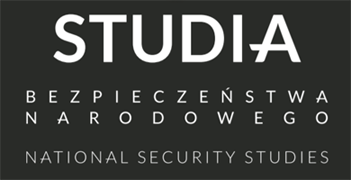Najnowszy Numer
Archiwum
O Nas
Międzynarodowa Rada Naukowa
Rada Redakcyjna
Kontakt
Recenzenci
Standardy etyczne
Standardy etyczne czasopisma (COPE)
Polityka Open Access
Procedura zabezpieczająca oryginalność publikacji
Dla Autorów
Wymagania Edytorskie
Wytyczne Merytoryczne
Proces Recenzji
Dla Recenzentów
ARTYKUŁ PRZEGLĄDOWY
STAN ŚRODOWISKA CYBERNETYCZNEGO I NARODOWA STRATEGIA CYBERBEZPIECZEŃSTWA W KRAJACH ROZWINIĘTYCH
1
The War College of the Armed Forces of the Republic of Azerbaijan, Azerbaijan
A - Koncepcja i projekt badania; B - Gromadzenie i/lub zestawianie danych; C - Analiza i interpretacja danych; D - Napisanie artykułu; E - Krytyczne zrecenzowanie artykułu; F - Zatwierdzenie ostatecznej wersji artykułu
Data publikacji: 30-03-2022
Autor do korespondencji
Elshan Elyar TANRIVERDIYEV
The War College of the Armed Forces of the Republic of Azerbaijan, Kara Karaev avenue 22. Flat 9, AZ 1060, Baku, Azerbaijan
The War College of the Armed Forces of the Republic of Azerbaijan, Kara Karaev avenue 22. Flat 9, AZ 1060, Baku, Azerbaijan
SBN 2022;23(1): 19-26
SŁOWA KLUCZOWE
bezpieczeństwo informacjiwojna informacyjnacyberbezpieczeństwocyberprzestrzeństrategia cyberbezpieczeństwacyberatak
DZIEDZINY
STRESZCZENIE
W artykule przeprowadzono analizę stanu cyberbezpieczeństwa w krajach rozwiniętych, przegląd strategii dostępnych w tym obszarze oraz ich wspólne i wyróżniające cechy w celu zbadania zaawansowanych praktyk w zakresie opracowywania i doskonalenia krajowej strategii cyberbezpieczeństwa. Celem artykułu jest analiza i porównanie narodowych strategii cyberbezpieczeństwa krajów rozwiniętych. Zastosowano metody: badania dokumentów źródłowych oraz analizy statystycznej.
REFERENCJE (13)
1.
Hasanov, A.H. (2106). Factors determining the importance of creating a cyber army in the Armed Forces of the Republic of Azerbaijan. National Security and Military Sciences, No. 2.
2.
Hasanov A.H., Iskandarov X.I. (2017). NATO’s Cybersecurity Policy and Azerbaijan. National Security and Military Sciences, Baku, No 2 (3).
3.
Imamverdiyev Y.N. (2013). Analysis of national cybersecurity strategies, “I Republican scientific- -practical conference on information security problems” dedicated to the 90th anniversary of the national leader of the Azerbaijani people Heydar Aliyev, May 17-18, p. 14-17.
4.
Sood A.K., Enbody R.J. (2013). Targeted cyberattacks: a superset of advanced persistent threats / IEEE Security & Privacy, 2013, Vol. 11, No. 1.
5.
Luiijf H., Besseling K., Spoelstra M., de Graaf P. (2011) Ten national cyber security strategies: a comparison. Proc. 6th International Conference on Critical Information Infrastructures Security (CRITIS 2011), September.
6.
US Government Accountability Office. (2009) National cybersecurity strategy: Key Improvements are Needed to Strengthen the Nation’s Posture, GAO-09-432T.
7.
Mitra A., Schwartz R.L., From cyber space to cybernetic space: rethinking the relationship between real and virtual spaces // Journal of Computer-Mediated Communication’s, 2001, Vol. 7, No. 1. http://jcmc.indiana.edu/vol7/i... [access: 11.02.2022].
8.
National Audit Office. (2013). The UK cyber security strategy: Landscape review, February.
9.
ENISA. (2012). National cyber security strategies: Setting the course for national efforts to strengthen security in cyberspace.
10.
Chałubińska-Jentkiewicz K., Radoniewicz F., Zieliński T. (2022). Cybersecurity in Poland Legal Aspects.
11.
Ministry of Digital Affairs (2019). Cybersecurıty Strategy of The Republıc of Poland for 2019-2024, https://www.gov.pl/attachment/... [access: 11.02.2022].
12.
Resmi Gazete (2013). National Cyber Security Strategy and Action Plan for 2013-2014. www. resmigazete.gov.tr [access: 11.02.2022].
13.
Klimburg, A. (Ed.) (2012). National cyber security framework manual, NATO CCD COE Publication,Tallinn.
Udostępnij
Przetwarzamy dane osobowe zbierane podczas odwiedzania serwisu. Realizacja funkcji pozyskiwania informacji o użytkownikach i ich zachowaniu odbywa się poprzez dobrowolnie wprowadzone w formularzach informacje oraz zapisywanie w urządzeniach końcowych plików cookies (tzw. ciasteczka). Dane, w tym pliki cookies, wykorzystywane są w celu realizacji usług, zapewnienia wygodnego korzystania ze strony oraz w celu monitorowania ruchu zgodnie z Polityką prywatności. Dane są także zbierane i przetwarzane przez narzędzie Google Analytics (więcej).
Możesz zmienić ustawienia cookies w swojej przeglądarce. Ograniczenie stosowania plików cookies w konfiguracji przeglądarki może wpłynąć na niektóre funkcjonalności dostępne na stronie.
Możesz zmienić ustawienia cookies w swojej przeglądarce. Ograniczenie stosowania plików cookies w konfiguracji przeglądarki może wpłynąć na niektóre funkcjonalności dostępne na stronie.


